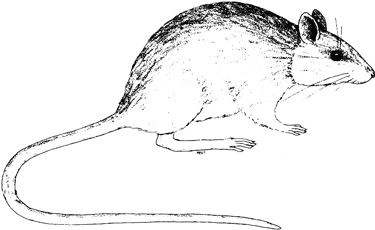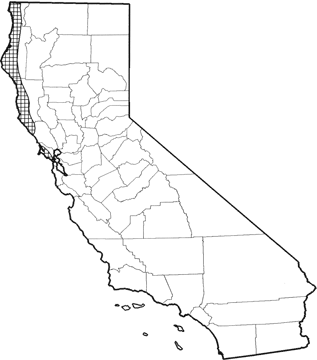
Pacific Jumping Mouse
Distribution, Abundance, and Seasonality
Occurs along the North Coast from Marin Co. north to the border of Oregon. It is locally common to abundant in riparian, grassland, and wet meadow habitats, and somewhat less common in grassy understory of open canopied coniferous forest habitats. Occurs in the narrow, humid, fog zone of North Coast forests, usually along creek banks, or under ferns and herbs in the forest (Howell 1920, Bailey 1936, Gannon 1988).

Range Map
Specific Habitat Requirements
Feeding: Eats primarily wild grass seeds, but also seeds of skunkcabbage, berries, some fungi, and insects (Marcot 1979). Maser and Franklin (1974) found that along the Oregon coast, ate the fruits of thimbleberry, salmon-berry, and evergreen huckleberry, and the seeds of skunkcabbage, among other foods. Cuts off the stems of grasses and eats the seeds (Bailey 1936).
Cover: In summer, grassy nests are constructed on the ground beneath dense vegetation or slash. In winter, burrows are excavated in moist soil and nests of fine grass, shredded paper (when available), or moss are constructed.
Reproduction: During summer, well-hidden, fragile, spherical or dome-shaped nests are constructed of grasses (or moss in bogs). Nests apparently are for 1 individual, and have only 1 entrance, on the side. Size approximately 15 cm (6 in) in diameter, and 23-25 cm (9-10) in height (Taylor and Shaw 1927, Maser et al. 1981). Young are born in these grass nests.
Water: No data found, but probably requires, or prefers, free water.
Pattern: Dense, herbaceous growth in moist areas beneath, or near, coniferous forest is preferred habitat.
Species Life History
Activity Patterns: Nocturnal, though occasionally seen in daytime (perhaps flushed from ground nests). Hibernates during the winter, beginning in late October and early November (Svihla and Svihla 1933, Svihla 1941).
Seasonal Movements / Migration: None.
Home Range: No data found.
Territory: No data found.
Reproduction: Breeds from May to September, with peak in late May to late August (Marcot 1979). Gestation period probably about 18 days (as it is for Z. hudsonicus, Godin 1977). Litter size probably averages 5 young (range 4-8). One or 2 litters/yr. Weaning occurs at about 4 wk (Godin 1977). Sexual maturity is achieved in the spring following birth.
Niche: A poorly known resident of the north coastal redwood zone. Its distribution seems to be confined to the fog-drip zone in California. Apparently hibernates in cold, foggy weather (Ingles 1965). Predators include foxes, coyotes, house cats, hawks, owls, snakes, and fish. An agile swimmer (Bailey 1936).
Sources & References
California Department of Fish and Game, 1999.
California's Wildlife, Sacramento, CA.
Written by: P. Brylski, reviewed by: H. Shellhammer, edited by: R. Duke
Bailey, V. 1936. The mammals and life zones of Oregon. U.S. Dep. Agric., North Am. Fauna No. 55. 416pp. Gannon, W. L. 1988. Zapus trinotatus. Mammal. Species No. 315. 5pp. Godin, A. J. 1977. Wild mammals of New England. Johns Hopkins Univ. Press, Baltimore, MD. 304pp. Howell, A. B. 1920. Contributions to the life history of the California mastiff bat. J. Mammal. 1:111-117. Ingles, L. G. 1965. Mammals of the Pacific states. Stanford Univ. Press, Stanford, CA. 506pp. Krutzsch, P. H. 1954. North American jumping mice (genus Zapus). Univ. Kans. Nat. Hist. Publ. 7:349-372. Marcot, B. G., ed. 1979. California wildlife/habitat relationships program: North Coast/Cascade Zone. Vol. III. Mammal narratives. U.S. Dep. Agric., For Serv., Six River Natl. For., Eureka, Calif. 261pp. Maser, C., and J. F. Franklin. 1974. Checklist of vertebrate animals of the Cascade Head Experimental Forest. USDA. For. Serv. Resour. Bull. PNW-51. 32pp. Maser, C., B. R. Mate, J. F. Franklin, and C. T. Dyrness. 1981. Natural history of Oregon coast mammals. Pac. Northwest For. And Range Exp. Sta., USDA, For. Serv., Gen. Tech. Rep., PNW-133. 496pp. Svihla, A. 1941. The relation of water to dormancy in mammals. Murrelet 22:15-18. Svihla, A., and R. D. Svihla. 1933. Notes on the jumping mouse Zapus trinotatus trinotatus Rhoads. J. Mammal. 14:131-134. Taylor, W. P., and W. T. Shaw. 1927. Mammals and birds of Mount Ranier National Park. U.S. Govern. Printing Off., Washington, DC. 249pp. Williams, D. F., and J. S. Findley. 1979. Sexual and size dimorphism in vespertilionid bats. Am. Midl. Nat. 102:113-126. Williams, D. F. 1986. Mammalian species of special concern in California. Calif. Dept. Fish and Game, Sacramento. Admin. Rep. 86-1. 112pp.
California Animal Facts | California's Wildlife